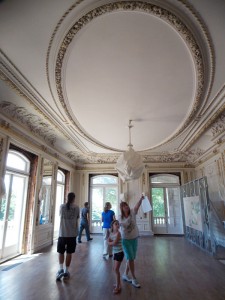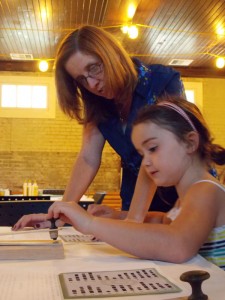PART TWO OF TWO
In this two-part series, Northeast News examines the relationship between the Kansas City Museum and Union Station Kansas City and the future of the Kansas City Museum.
By LESLIE COLLINS
Northeast News
July 24, 2013
For 13 years, the Kansas City Museum has been intertwined with Union Station Kansas City, and now the museum wants a divorce.
“It is clear that there is a desire among museum related persons that they want a separation,” said Kansas City Museum Advisory Board (KCMAB) Chair Martha Lally during the board’s June 12 meeting.
In 2000*, Union Station and the Kansas City Museum merged their individual governing boards (Kansas City Museum Association and Union Station Assistance Corporation) to form Union Station Kansas City, Inc. to unify management of Union Station, Science City and the Kansas City Museum.
“This is a logical next step in the redevelopment of Union Station and the development of Science City as a premier destination in Kansas City,” then-Chief Executive Officer of Union Station Turner White told Northeast News in 2000.
“We’re really excited about all of it,” Mary S. Bloch, then-chair of the Kansas City Museum Association, told Northeast News at the time. “The concern for us in Northeast has been that Corinthian Hall is in the shadow of Science City, but this will allow us to dedicate more resources to Corinthian Hall.”
Despite Bloch’s optimism, the Kansas City Museum has remained in the shadow of Union Station, according to the Kansas City Museum Business Plan dated July 7, 2013.
“Prior to merging with Union Station, KCM (Kansas City Museum) had a mature and well-developed governance and fundraising apparatus capable of generating revenue sufficient to support a staff of more than 50,” the Business Plan stated. “After merging, the development function shifted to Union Station that allocated minimal resources to museum fund development.”
Union Station staff focused instead on stabilizing the Station’s finances, the Business Plan stated.
“Union Station’s historic financial instability generated questions from funders who wanted assurance (that) funding would be allocated to KCM,” the Business Plan stated. “Funders also wondered about the benefit of the Union Station/KCM relationship. At times, KCM was ineligible for funding applications because an institution had already given to Union Station and couldn’t write a check to the institution again even for a different use.”
According to the Business Plan, when Jackson County awarded a $15,000 program grant in 2009 to the Kansas City Museum, Union Station redirected those funds to support Science City Summer Camp. Then, in 2011, the Frances Family Foundation rejected a 2012 program grant request, citing a “lack of engagement” from Union Station’s board of directors.
Kansas City Museum Funding
Kansas City Museum’s primary source of funding comes from the 2 mil Museum Tax Levy, which the state legislature passed to support museums that were in existence on Aug. 13, 1978. Annually, the Kansas City Museum receives $1.4 million from the mil levy. In 2004, Union Station officials tried to convince the Kansas City City Council to place a proposed mil levy increase on the August ballot, increasing the tax to 10 mils. Due to the 2000 merger, Union Station said it would be eligible to receive a portion of the increase. Union Station Kansas City, Inc. proposed that 3 cents of the levy would go toward the Kansas City Museum and the remaining 7 cents would go toward operations at the Union Station facility. By 2004, Union Station had already collected the one-time funding of $118 million from the Bistate Cultural Sales Tax to renovate Union Station as well as create a science museum.
According to a 2004 Museum Tax Levy document released by Union Station, “Currently, every dollar earned at Union Station goes toward operating expenses, leaving virtually no capital for new attractions and other amenities… The Station’s annual operating deficit is between $5 million and $6 million a year. The current year’s (2004) operating deficit is expected to be $6.2 million.”
The Kansas City City Council never approved the ballot initiative.
Museum History and Management Agreement
Millionaire and lumber baron Robert A. Long and his family once lived in the grand mansion that now houses the Kansas City Museum. For nearly a decade, the Kansas City Museum Association owned and operated the grounds and buildings of the Kansas City Museum, 3218 Gladstone Blvd., but sold the property to the city of Kansas City in 1948.The city still owns the property and entered into a 20-year management agreement with Union Station Kansas City, Inc. in 2007, which put Union Station Kansas City, Inc. in charge of museum operations. The agreement gave Union Station Kansas City Inc. full access to the museum’s mil levy funds to store and care for artifacts owned by the city and Union Station.
With Union Station now operating in the black, some critics have pondered if that success resulted from siphoning mil levy funds. During the June 12 KCMAB meeting, City Council and KCMAB member Scott Wagner said he didn’t know how Union Station Kansas City, Inc. was spending the mil levy and wanted to find out. It’s one of the reasons he sponsored an ordinance requesting the city auditor to conduct an audit of the management agreement with Union Station. The audit’s scope statement is scheduled to be presented during the city’s Finance, Governance and Ethics Committee meeting on July 31, nearly five months behind schedule.
Entering into the management agreement also created controversy with collections ownership. According to the agreement, the city owns the museum’s collections acquired before Oct. 6, 1970. Items acquired on or after Oct. 6, 1970 by Union Station or its predecessor (the Kansas City Museum Association) belong to Union Station Kansas City, Inc.
KCMAB believes it’s now impossible for citizens to donate specifically to the Kansas City Museum and that Union Station owns everything acquired after Oct. 6, 1970. Northeast News contacted Assistant City Attorney Joseph Guarino for a legal opinion. In addition to the 1970 clause, page two of the agreement states, “Property acquired by a donation to the Kansas City Museum, shall be property of the City.” Guarino said citizens can still donate specifically to the Kansas City Museum and those items then become property of the city, not Union Station. In addition, items acquired through mil levy funding become property of the city, he said.
Not all donations are being properly classified, however. Northeast News Publisher Michael Bushnell recently donated items to the Kansas City Museum and received a letter from Union Station thanking him for his donation to Union Station, not the Kansas City Museum.
During the June 12 KCMAB meeting, KCMAB member Amy Hull noted several issues with the collections process.
“When an individual or corporation approaches the ‘Museum’ to donate artifacts, they are given no other avenue of donation than to Union Station Kansas City…” Hull’s written presentation stated.
One individual donated antique photographs of the Long family to the museum, which became classified as a donation to Union Station. When that individual questioned why Union Station received the donation, the individual was told there was no other way to donate. Another example Hull cited included a vast collection of significant photographs that the Jackson County Historical Society received, instead of the museum, due to collections issues with Union Station.
Loss of Accreditation
Adding to the rocky relationship with Union Station is the fact that the Kansas City Museum lost its accreditation with the American Alliance of Museums (AAM) as a direct result of Union Station’s financial instability. KCMAB recently submitted documents to the city outlining why the Kansas City Museum should split from Union Station and cited loss of accreditation as one of the reasons. According to the documents, the Kansas City Museum will never regain accreditation as long as it’s associated with Union Station. In a letter written to KCMAB, AAM President Ford W. Bell explained the relevance of accreditation to museums.
Bell called accreditation the “Good Housekeeping Seal for America’s museum’s” and said some states, like Florida, require museums to have AAM accreditation in order to receive state funding. Foundations, philanthropies and international museums also require AAM accreditation. Lack of accreditation can also affect the ability to secure future exhibits.
“Museums around the world prefer to loan objects to accredited museums,” he said.
In the board approved Kansas City Museum Business Plan, KCMAB said the Kansas City Museum can survive without Union Station, citing the stable funding source of the mil levy. For museum renovations, the board would apply for grants and seek private donations.
Nixing the Union Station contract would save at least $30,000 annually in operations, KCMAB reported.
According to a source close to Union Station, the Union Station Kansas City Board is ready to split from the Kansas City Museum.
“Just beat the drums. Just keep beating them because it’s working,” the source urged community members. “USKC (Union Station Kansas City) is sick of dealing with this. Their board of directors is sick of dealing with this and they want to get away from it (community outrage over Leitch’s firing and the future of the museum).
“The city manager and the mayor agree that (Union Station Kansas City CEO) George (Guastello) has lost favor with city hall. The impression I got was that the community response they’re getting, primarily from Northeast residents and also from campaigns around the city and from a variety of groups, they’re turning things around at city hall. It’s going to make a difference, but we’ve got to keep the pressure on and hold the line.”
*In Part I of our series, we reported that the merger occurred in 2001, which is the year listed on the Kansas City Museum’s website. However, the merger actually occurred in 2000.


















